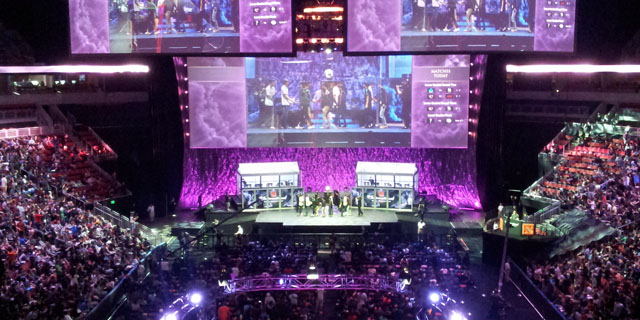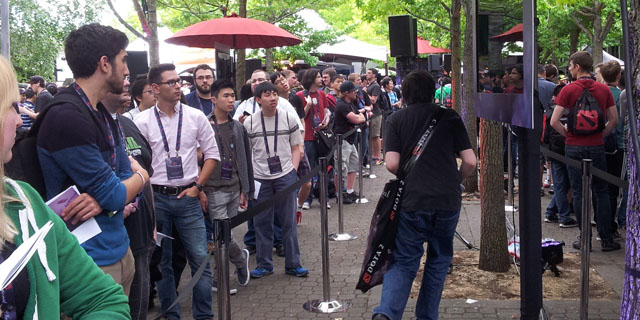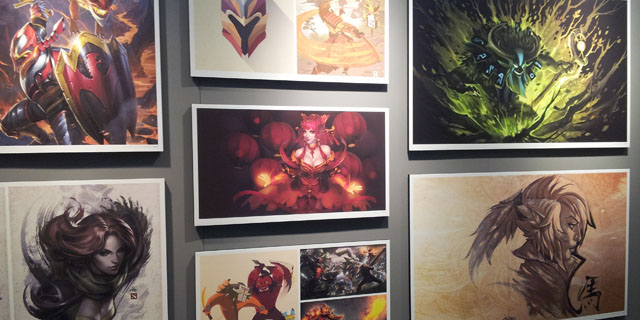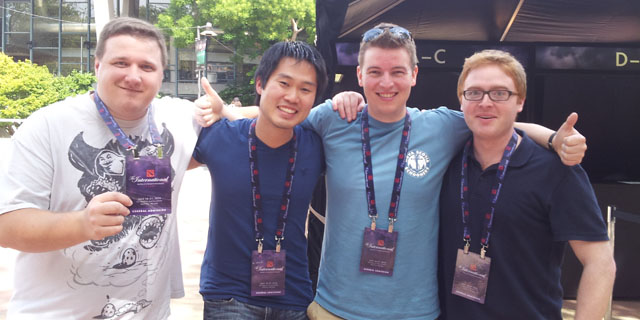
I’ve written about LAN parties before, but I’ve never been to anything like this. The International 2014, the championship tournament for Dota 2, was held in Seattle from July 18 to 21. It was easily the biggest spectacle in competitive gaming. It was certainly the most lucrative, as the collective prize pool was over 11 million dollars, with the winning team taking home almost half of that. But how was the event? Was it successful? What does it mean for gaming? And, of course, how did it make me feel?
I can say, unequivocally, that it was the most distinct-feeling event I’d ever been to. I’ve been to every live sporting event you can imagine: soccer, football, basketball, hockey, cricket, golf and professional wrestling, to name a few. I’ve been to a few concerts, many theatrical productions, Broadway musicals and magic shows. I’ve even attended and participated in video game tournaments, but compared to this, that’s like saying I’m prepared for a cross-Atlantic swim after taking a bath.
The sheer scope was impressive. I’d heard the numbers of 10,000 or 12,000 thrown around, but the actual size didn’t hit me until I was sitting in my seat, in the stadium, surrounded by other people. I looked to my left and saw endless rows of fans, cheering on their favorite team. The upper bowl was absolutely packed. There were lines to get in the arena, lines for washrooms, lines for concessions, lines for everything. I quickly realized that despite the game’s relative niche status, it was anything but niche in Seattle. Everywhere I went, there were fans. I saw lanyards and tickets around the necks of people at restaurants, bars, grocery stores and walking around on the street. Everywhere I went, I couldn’t escape it. That kind of confirmation that your hobby is shared by tens of thousands, all around you, is thrilling.
The core of the event is watching the top eight teams in the world playing matches of Dota 2. A tournament called “The International” wouldn’t be appropriate if it didn’t have teams from all over the world; players heralded from Ukraine, China, Malaysia, Estonia, Canada, the Netherlands, the United States, Sweden and Russia. It showed in the fan base, as well; the variance of flags being proudly displayed inside the playing area made me proud to be a fan of the game and instilled a strange sense of digital jingoism. See? We all get along through a common interest. Our lack of hostility, pride in belonging and ease of respectful conversation stems from a video game that makes you want to stab yourself in the ear every ten minutes out of mounting frustration. Huh.

It was a show, much like how going to see the Seattle Seahawks live is more of a rock concert than a straight-up football game. The International had pre-game and post-game analysis for every match. It had professional commentary, and like the commentators in “real” sports, their job was to keep us updated on the action but also subtly explain the rules. This is a monstrous challenge; Dota 2 has so many intricate details, spontaneous strategies and changes in momentum that a lesser talent would be better off just announcing the obvious plays and leaving it at that.
My girlfriend joined us and was a very good sport about it. There were very few girls at the event (even fewer who weren’t dressed up in cosplay), and she was relatively new to the game. She was my measuring stick of what appeal this would bring an inexperienced player. Valve would be wise to use her (and other rookie observers’) feedback.
“I really wish they would ensure we know everybody’s back story. It makes me care so much more about the teams and helps me choose who I want to win.”
Me too.
“The different art pieces on the wall are amazing; I can’t believe how beautiful they are.”
Me too.
“Exactly how long is the line to the secret shop?
I am also wondering that.
Ultimately, what surprised me the most about the event was not the quality of the games (which was overall quite good), nor the mass hordes that attended each match with bated breath, but the economy that Valve has created, and the star of this particular show was the secret shop.

I knew the game was popular. It may be totally unknown to the layman, but to the hardcore, it’s not exactly the new kid on the block. I also knew that Gabe Newell, the co-founder of Valve, is the Mephistopheles of making money via microtransactions. So I should have known how insanely popular the exclusive physical items at The International would be.
How popular? The wait to buy them on day one was approximately five hours long. A pleasant mob showed up before 8 a.m. to ensure an early spot and chance to purchase such epic goods as plush toys, hoodies and pint glasses with Crystal Maiden on it. Frostbite Lager is delicious, by the way.
The lineup snaked outside, made its way into the arena and all the way around the upper hallway and back again. Very few opportunities presented themselves to engage in activities other than line attending; going to the bathroom meant risking your spot in line, although TVs were sporadically set up to allow the brave economists to watch what they came for in the first place. Their reward? Extremely valuable collectibles.
Being first in line, or among the first hundred or so, netted you a chance to purchase, essentially, as much as you want. There were rumored limits to how many or how much an individual could buy, but there were also rumors that a guy from Singapore somehow purchased $13,000 worth of goods that immediately ended up on eBay.
There’s something unsettling about a $20 figurine going for $150 before you even knew you could buy it. The mini economy, and fervor at which participants stood in line, was puzzling, intimidating and it totally piqued my curiosity. After looking at the sales catalog and seeing the lack of hesitation to buy… yeah, of course we got in line. It wasn’t until the end of day two and we were lucky enough to “only” have to wait an hour and 45 minutes. As punishment for our tardiness, much of the stock was already out. Female jackets and hoodies were gone. Nearly all the T-shirts, plush toys and figurines were cleaned out. The look on my buddy’s face when they told him this was identical to the same face he made when we told him it would take at least a few hours to line up. Neither remotely resembled pleasant.

The community marketplace didn’t end there; the artists had performing workshops in the arena for aspiring artists, demonstrating how to create mythical robots, terrifying demons and shadowy animal assassins. Dota 2 celebrities were often found circulating the arena, taking photos and chatting with the eager ticket holders.
There were some definite drawbacks that sparked some anger upon our little group. Watching teams battle back and forth in the matches was exhilarating. The commentators were getting appropriately excited at the right times, some insane strategies emerged that nobody could have predicted and there were more than a few near-impossible comebacks. But near the end of the tournament, a few results had us shaking our heads in disbelief. If a team captain types “gg” (good game), it’s a forfeit and the match is immediately over. In the final five games of the tournament, we saw an average match length of under 20 minutes before one of the teams gave up. With an ultimate prize of five million dollars, I felt the forfeits came far too easy. Where was the heart? This was what I’d waited for? A pathetic few final games certainly soured the overall quality of the matches.
Part sport, part Vegas imitation, The International was a truly special event for me and my friends. Seeing how dedicated the fans were, and how efficient Valve was at ensuring them that this was a welcoming event, was a thrill in itself. Many of the people I talked to had played the original DOTA, more than ten years ago. How a mod made by a few people spawned into the greatest video game event the world has even seen? I’ll never know. How a free game entices thousands of people to spend their vacation days lining up to buy a digital cape for their favorite hero for $8.99 is totally beyond me.



















